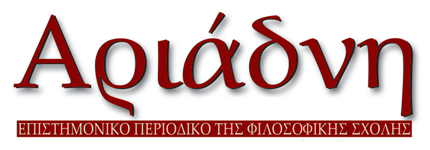Θρήνος για τον πετεινό
DOI:
https://doi.org/10.26248/ariadne.v13i0.942Περίληψη
AMONG the fragments of the so-called ‘Popular Mimes’ there is one known as ‘Lament for a Cock’ (fr. 4 Cunningham), found in Egypt among documents dated to the 1st cent. AD: an apparently young man breeding fighting cocks to make his living, now ‘shipwrecked’ (but this may only mean ‘hopeless’), laments the loss of his champion, who deserted him out of attraction to a hen (described with the apparently learned but ironic term θακαθαλπάς). The fighting cock theme is not known from another mime, but a breeder of fighting cocks uses his animals to make a profit like the pimp in the 2nd mimiamb of Herondas uses his girls for the same purpose. The theme of the loss of a hen harks back to Ancient Comedy. In the damaged lines, verses 9-14 may describe a walk, such as those undertaken by breeders to strengthen their cocks (Pl. Leg. 789c3). The fragment is far from primitive or ‘popular’: the protagonist is a complex figure comprising the roles of a pimp, a ‘shipwrecked’ traveller and a deceived friend or husband.
The surviving part, which may well come from the end of the lament, makes use of literary techniques known from ‘decent’ or ‘learned’ literature, such as a scenario with περιπέτεια, pathetic irony and studied ἀφέλεια. The driving motifs are borrowed from laments for the loss of a friend or husband/wife: our hero’s reminiscences (all related to cockfighting) are subverted with unremitting parody, a technique very much in place in a ‘learned’ mime such as this. Among the various things parodied seems to be the tendency of the breeders to attribute human feelings to their animals and their occasional infatuation with them. The attributes of beauty, valour and Greekness in 18 refer to the ancient Greek virtue of καλοκαγαθία, a lasting value that was important, particularly in athletic contests, among Greeks in multi-racial Egypt. A latent eroticism, never openly expressed, underlies many features of the fragment. The language of the lines may not be ‘poetic’, as the first editors (Grenfell and Hunt) thought, but rather the commonly spoken language of the day embellished with comedic elements.
Λήψεις
Δημοσίευση
Πώς να δημιουργήσετε Αναφορές
Τεύχος
Ενότητα
Άδεια
Οι εργασίες που δημοσιεύονται στο περιοδικό μπορούν να χρησιμοποιηθούν ελεύθερα για μη-εμπορικούς σκοπούς με την προϋπόθεση ότι γίνεται αναφορά στους συγγραφείς και την πρώτη δημοσίευση. Στην περίπτωση που το άρθρο αλλοιωθεί, τροποποιηθεί ή δημιουργηθεί κάτι νέο βασισμένο στο αρχικό, το έργο που θα προκύψει θα μπορεί να διανεμηθεί μόνο με την ίδια ή παρόμοια άδεια (Creative Commons Attribution-NonCommercial-ShareAlike 4.0 International License).


